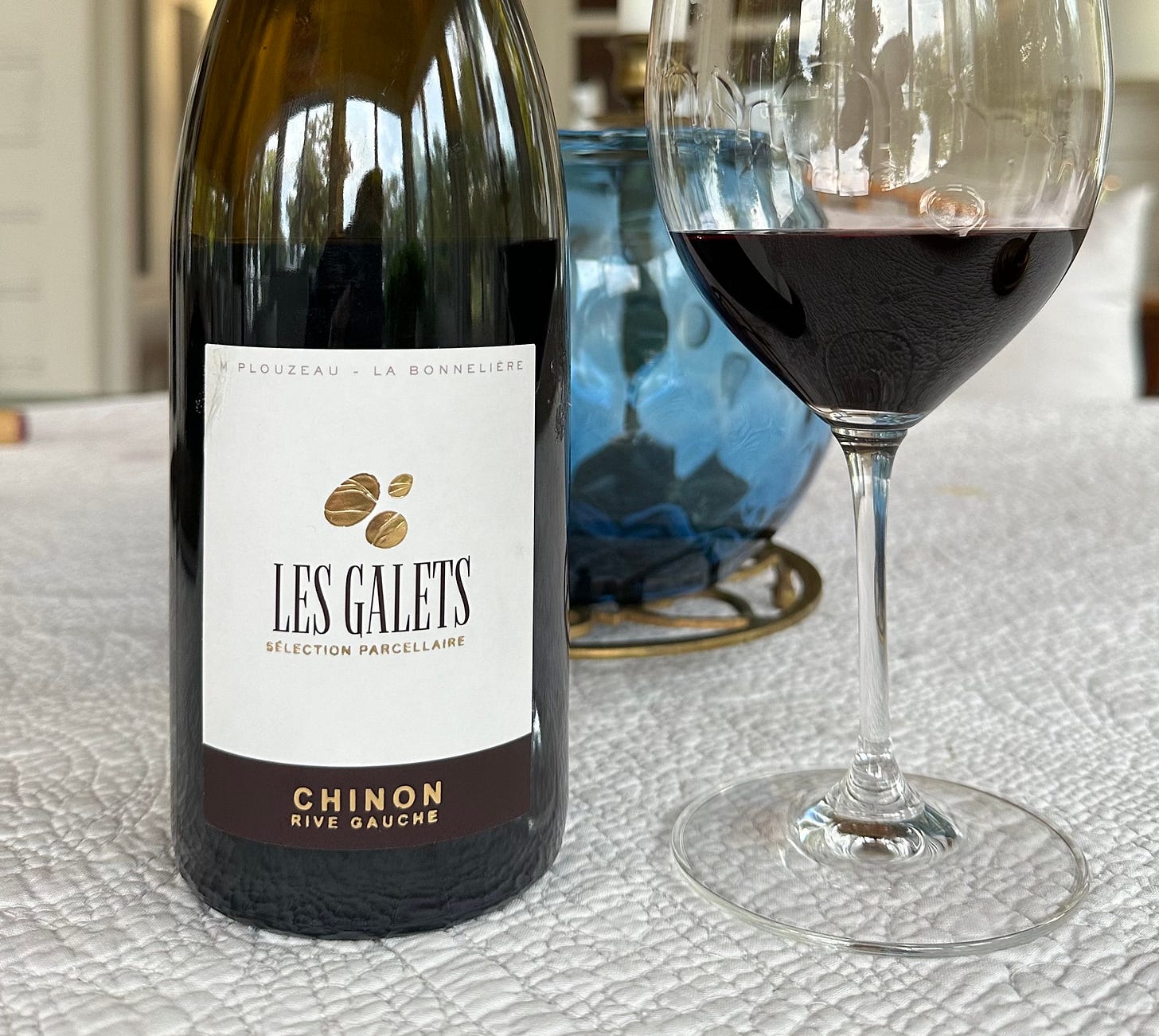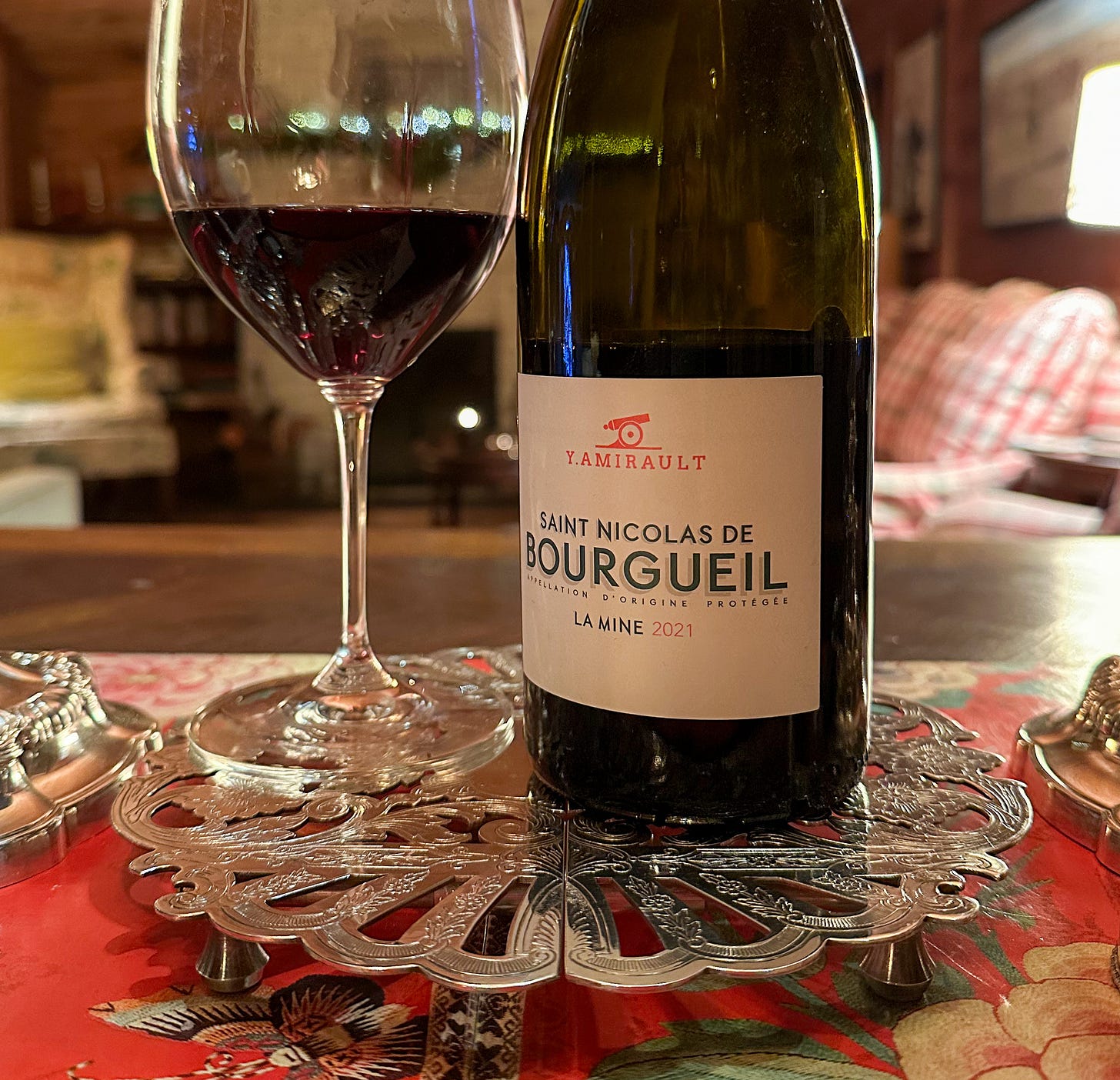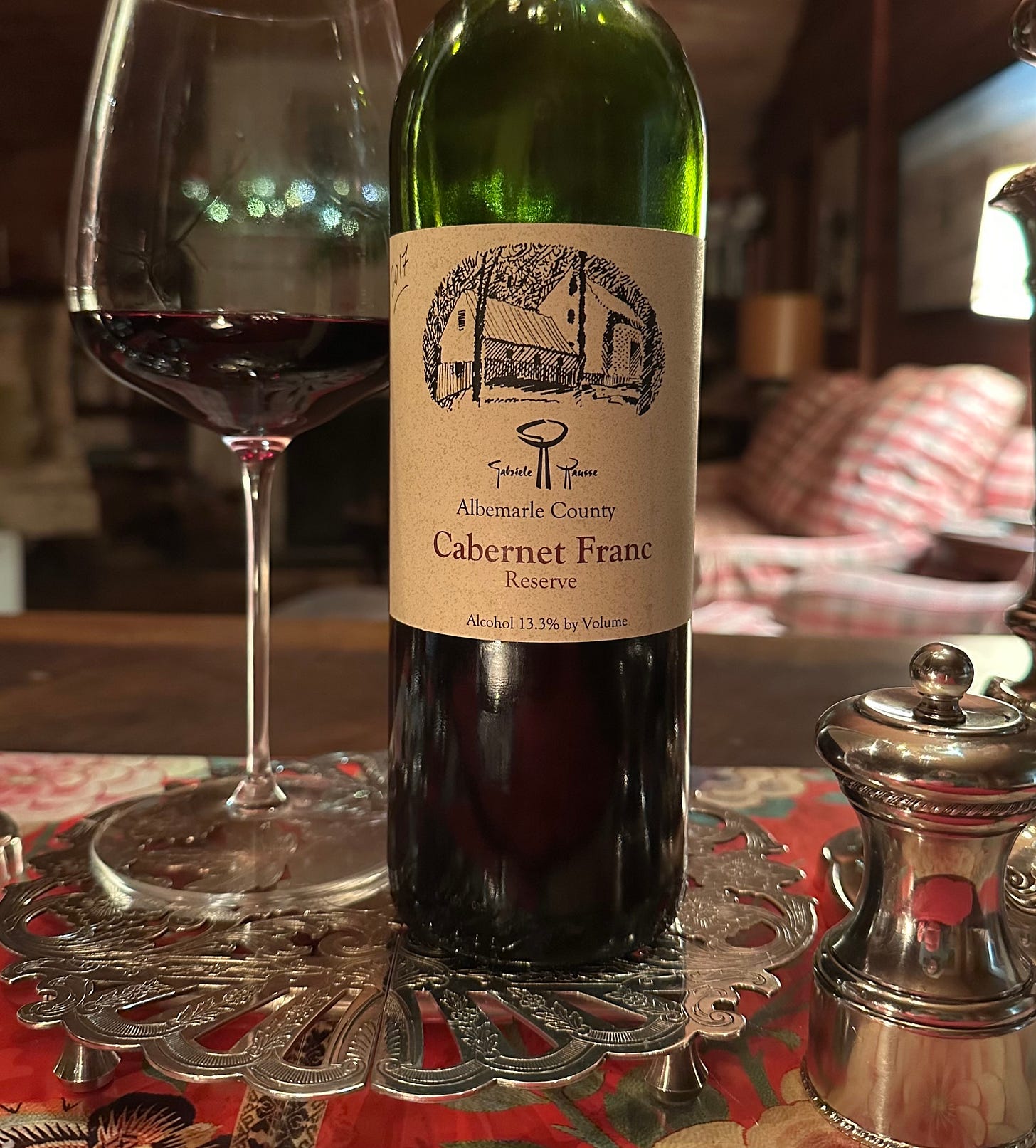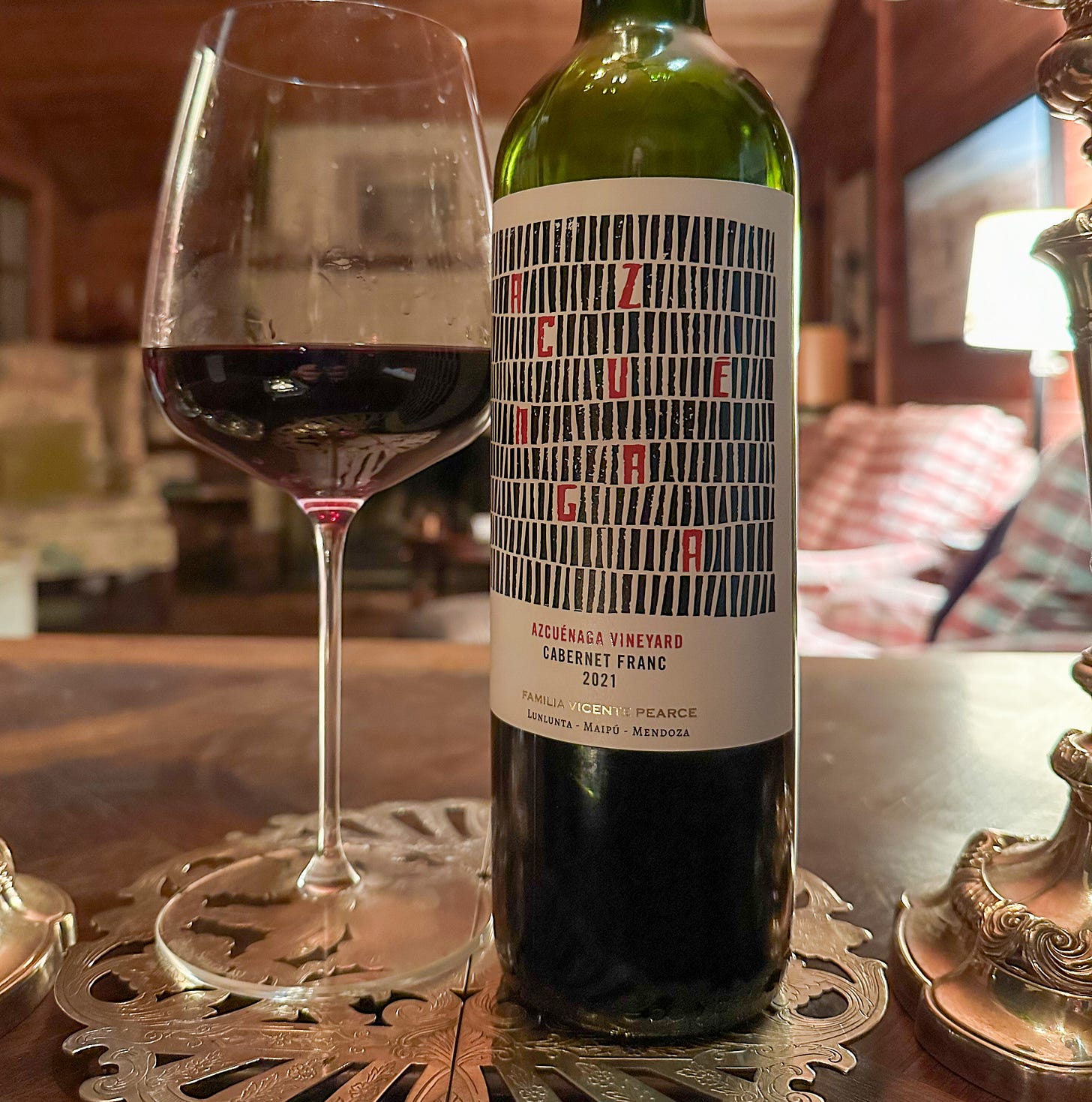Back in August, I wrote a post highlighting the versatility of Cabernet Franc as it relates to seasonal food pairings. As a grape that is capable of producing a wide array of styles and profiles, I am convinced that there is a Cab Franc out there for just about every dish imaginable. And now that the weather has turned chilly in the northern hemisphere, we are in prime red wine drinking season, so I thought I’d take a moment to share what I’ve been eating and drinking these last couple of months and suggest a selection of wines that can deliver a similar food and wine pairing experience.
Marc Plouzeau, 2022 Chinon “Les Galets” (13.5% abv, SRP $22USD): I know I’m biased, but as far as I’m concerned there is no better fall/autumn wine than Cabernet Franc. Particularly some of the early-drinking styles from the alluvial terroirs in the Loire Valley that deliver the right balance of herbal undertones, forest-y notes and bright red fruit. This example from Marc Plouzeau is from parcels in the communes of Chinon and La Roche-Clermault on the alluvial terrace on the left bank of the Vienne River. It is vinified in stainless steel, so it keeps this wine bright and lively. It opens with a mix of forest berries, evergreen notes and currant leaf, as well as some spicy undertones of black pepper and cardamom. With refreshing acidity and fine-grained, sandy tannins, the wine has plenty of ease and accessibility but it also has terrific density and weight to stand up to a number of different food pairings and occasions.
Pairs well with: I enjoyed this with a divine slow roast pork shoulder that had been rubbed in a mix of garlic, thyme, rosemary, and fennel seed. But a wine like this would honestly pair well with just about anything. A simple roast chicken with a side of seasonal roasted root vegetables, pasta alla norma or another eggplant based dish, roast ham or turkey over the holidays. You could even chill it down slightly and serve with some pork rillettes accompanied by sliced baguette and cornichons - a very classic Loire Valley food and wine pairing.
Similar wines to try: There are hundreds of examples of early-drinking wines from the alluvial terroirs across Chinon, Bourgueil and St-Nicolas-de-Bourgueil that could work in this scenario. Bernard Baudry’s Les Granges, Olga Raffault’s Les Barnabés or Philippe Alliet’s Vieilles Vignes are all great examples from Chinon. From Bourgueil or St-Nicolas-de-Bourgueil, you could reach for Domaine de la Lande’s Bourgueil “Cuvée Prestige,” Lamé Delisle Boucard’s “Cuvée Dechainée” or Xavier and Agnès Amirault’s St-Nicolas-de-Bourgueil “Les Quarterons.” Some favourites from this side of the Atlantic that deliver a similar experience would include Vineland Estate’s Cabernet Franc from the Niagara Peninsula in Ontario, which is a smashing value at $15.95CAD, or Lamoreaux Landing’s T23 Unoaked Cabernet Franc from the Finger Lakes in New York.
Yannick Amirault, 2021 St-Nicolas-de-Bourgueil “Les Mines,” (12.5% abv, SRP $30USD): The St-Nicolas-de-Bourgueil appellation is dominated by the ancient alluvial terrace, which is known to give very supple, easy drinking wines. However, like Bourgueil, there is an area of the slopes that has the influence of the Turonian tuffeau chalk, which can give wines with a bit more structure and verve. Domaine Yannick Amirault’s “Les Mines” is coming from the lieu-dit Les Malgagnes on the slopes in the eastern part of the appellation, and generally it is sourced from the top and bottom of the parcels, with the vines planted mid-slope going into the estate’s Les Malgagnes cuvée parcellaire bottling. Red fruit-driven, with undertones of fresh sage and damp cedar leaves, and a fresh cracked peppery hint of spice, the wine is focused and fresh with persistent acidity and fine, velvety tannins. Beautifully balanced, with a long minerally finish.
Pairs well with: I absolutely adore duck confit, and it seems to be a dish I crave in the fall and winter, rather than spring and summer. This wine’s bright acidity coupled with the delicate, yet firm, finely woven tannins works so well with the texture and fattiness of duck confit. I paired the duck with classic braised lentils, which brought an added level of earthiness that just works so well with this Cabernet Franc.
Similar wines to try: When it comes to duck confit, I actually tend to reach more for wines from Saumur or Saumur-Champigny as I think there is a certain refinement in these wines that works particularly well with this dish. The Les Mines gives a Saumur-like feel thanks to the influence of the Turonian tuffeau chalk. Other wines I would consider reaching for would be the Saumur Rouge from Domaine Guiberteau or Arnaud Lambert’s Saumur-Champigny “Terres Rouges” from parcels in St-Cyr-en-Bourg. And while not Saumur or Saumur-Champigny, I think Bernard Baudry’s La Croix Boissée from Chinon would be a fine pair with duck confit.
Gabriele Rausse, 2017 Cabernet Franc Reserve, Albemarle County, Virginia (13.3% abv, SRP $30USD): Gabriele Rausse is the father of Virginia wine. Having established over a hundred vineyard sites across the state, including those at the renowned Barboursville Vineyards, the Virginia wine industry today would not be where it is without his contribution. Today, his two sons, Tim and Peter, are now involved in the winery, and they produce elegant, old school examples of Cabernet Franc. This 2017 was a cellar raid for me, a bottle I purchased at the winery back in the fall of 2020. It was in such a terrific place. Understated, refined, classic, opening with a very Bordeaux-esque profile of red fruits, cedar, tobacco, dried bay leaf and balanced oak spice. All the wine’s structural components were beautifully integrated, and with added tertiary layers of forest floor and mushroom. This is why we age Cabernet Franc! It can reveal so much allure and complexity with time.
Pairs well with: Mushrooms! Cabernet Franc with some bottle age can be splendid with mushroom-forward dishes. I paired this with a classic wild mushroom risotto, but I think it would also work with this terrific recipe that uses farro, which has a lovely nuttiness that amplifies the earthy profile of the dish and it is topped with dill for a bit of green, herbally freshness.
Similar wines to try: I appreciate that not everyone has well-aged Cabernet Franc at their disposal. But honestly, I think Cabernet Franc in general is a terrific wine for mushroom dishes. Consider seeking out Bordeaux-inspired/styled examples from the cooler climate “New World” regions (ie. New York, Ontario, Washington State) that have seen some neutral oak aging. Such as the Macari Vineyards Estate Cabernet Franc from Long Island, or Fjord Vineyards Cabernet Franc from the Hudson Valley. Another favourite is the Owen Roe “Rosa Mystica” Cabernet Franc from the Yakima Valley in Washington State. If Loire Cabernet Franc is more your jam, there are a few producers that release or re-release older vintages from time to time, which means they’ve done the cellaring so you don’t have to! Olga Raffault’s 2018 Chinon Les Picasses has recently hit the market in North America and Europe, and I’ve recently expounded the virtues of Domaine de la Chevalerie’s line-up of single lieu-dit wines that often have at least five to upwards of ten years of bottle age.
Familia Vicente Pearce, 2021 ‘Azcuenaga Vineyard’ Cabernet Franc, Lunlunta, Maipu, Mendoza, Argentina (14.3% abv, SRP $21USD): When the weather gets chilly, I often reach for warm climate Cabernet Francs that have a bit more generosity and flesh, while being restrained and having a balanced use of oak. From the cooler sub-region of Lunlunta in Maipú and from older vines planted in 1990, this 2021 Cabernet Franc shows all the typicity I’ve come to appreciate from Argentinian Cabernet Franc - ripe, supple tannins, a classically “sunny” and plummy fruit character and a balanced mix of herbal undertones (bay leaf, dried mint and basil) and spice (nutmeg, chilli flake) - wrapped in a very elegant package with refreshing acidity to balance the plushness of fruit. Such a pleasure to drink!
Pairs well with: With a bit more weight and balancing acidity, this wine works very well with hearty braises such as osso bucco, classically prepared braised short ribs or beef cheeks. I paired this with a lovely slow roasted lamb shank with mint and mustard.
Similar wines to try: We are starting to see more and more examples of Cabernet Franc from both Argentina and Chile that are less about ripeness and oak, and more about terroir and highlighting the grape’s varietal character in an elegant way. Some classic examples to reach for include Catena Zapata’s ‘San Carlos’ Cabernet Franc, Zuccardi’s Poligonos Del Valle De Uco San Pablo Cabernet Franc both from the Uco Valley in Argentina, or from Chile’s Pirque D.O., which is highly regarded for its wines from the Bordeaux varieties, the Garage Wine Co.’s Pirque Vineyard Cabernet Franc and the Haras de Pirque ‘Galantas’ Cabernet Franc Gran Reserva are both nice options. If you wanted to stay in Europe, consider reaching for something from the region of Villány in Hungary, such as the Malatinszky Kúria Cabernet Franc, or head to Tuscany and try the Emiliano Falsini 'Il Debbio' Cabernet Franc. Both regions have warmer climates and these are great examples of plush, voluminous, yet finesse-driven Cabernet Franc that is true to the grape and place.
What has been in your glass recently? Do you have any favourite food and wine pairings with Cabernet Franc? Drop some of your suggestions in the comments below!








